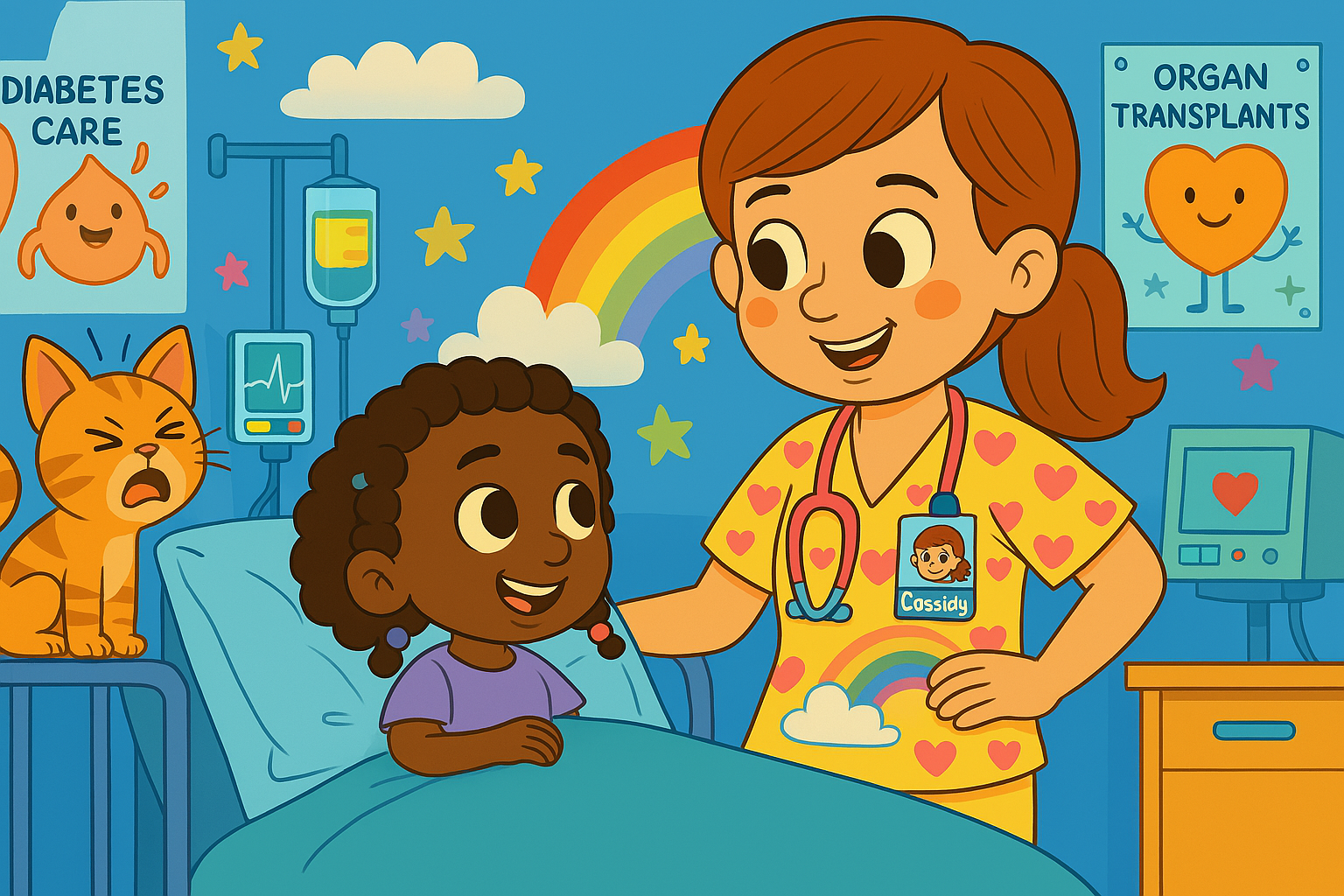#564 Diabetes Variables: Pump Site Placement
Diabetes Variables: Pump Site Placement
Scott and Jenny Smith, CDE share insights on type 1 diabetes care
You can always listen to the Juicebox Podcast here but the cool kids use: Apple Podcasts/iOS - Spotify - Amazon Music - Google Play/Android - iHeart Radio - Radio Public, Amazon Alexa or wherever they get audio.
+ Click for EPISODE TRANSCRIPT
DISCLAIMER: This text is the output of AI based transcribing from an audio recording. Although the transcription is largely accurate, in some cases it is incomplete or inaccurate due to inaudible passages or transcription errors and should not be treated as an authoritative record. Nothing that you read here constitutes advice medical or otherwise. Always consult with a healthcare professional before making changes to a healthcare plan.
Scott Benner 0:00
Hello friends, and welcome to Episode 564 of the Juicebox Podcast.
Friends Today I'm back with another episode of the diabetes variable series with Jenny Smith. Today's topic, as you saw in your podcast player is pump site placement. Please remember while you're listening that nothing you hear on the Juicebox Podcast should be considered advice, medical or otherwise, always consult a physician before making any changes to your health care plan. We're becoming bold with insulin. Jenny Smith is a guest on the podcast but she has a real job at integrated diabetes comm where she helps people with their diabetes in exchange for funds and goods as capitalism works. Integrated diabetes.com asked for Jenny. Now that I'm thinking about what I just said, I don't think you can exchange goods for services with Jenny. But I mean, you could ask try to trade a lamp for a better Pre-Bolus time. Are you a US citizen who has type one diabetes or a US citizen who is the caregiver of someone with type one, please if you are, go to T one d exchange.org. forward slash juicebox. Take the quick survey, help the podcast help people living with Type One Diabetes.
I want to put the ad right here because I don't like splitting up shorter episodes. But that's not what Contour Next One paid for. But I feel like they'd be okay with it if you guys promise just to listen to the ad, okay. All right, you promise to listen, and I'll do this so that you get an inner, an inner inner I was gonna say an interrupted, I meant an uninterrupted episode. with Jenny and I know this is this. It's a clunky start. But watch how I finish the Contour. Next One blood glucose meter is top shelf to understand it is super duper accurate, incredibly easy to use, and easy to hold and transport. This means it fits in your pocket, it fits in your purse, anywhere you need to keep your gear, the Contour. Next One slides right in and doesn't get in the way. It also has an incredibly bright light for you know, when you're sleeping, and it's dark. Room, it lights up like thing from a movie that we can't say because I think it's copyright infringement. And it allows the room to glow. It's as if heavenly light has shone down upon your finger. You strike it with a lance, click click, blood comes out. You take the Contour Next One meter, put in the strip, touch the strip to the blood. Oh, is it not enough blood, no big deal, this trip has a second chance to feature just get a little more blood, squeeze, squeeze, squeeze and go back and hit it again. You have not ruined the test strip by doing that, or ruin the accuracy of the test. Second Chance test strips from the Contour Next One blood glucose meter. I mean, what will they think of next. Also, the screen is incredibly easy to read. And if you would like to pair your meter to a rockin who is sending me text messages the middle of what? Hold on. Alright, I'm back. Sorry about that. If you want to pair the meter to an app Contour Next One has a really terrific app too. So you can use it with or without the app. Last thing I want to say is that well, you know, I want to say two last things. So last thing like let's call it one I want to say is that I'm always afraid that when I talk about Second Chance test strips that you'll think oh, this thing must need so much blood but it doesn't it needs a very little bit. It's not a big blood drop that you need. I'm just saying that if for some reason you don't get quite enough, you can go back and get more. Okay, last part go to contour next comm forward slash juicebox. There's like zero sincerely, I'm not just trying to drive you to a link, what am I really want you to go to the link. But that's not the point. There's a lot of information at the link. So if you really want to understand all this contour next.com forward slash juicebox. And I'm just going to finish with this. There are a lot of you walking around with subpar meters. It's not necessary. You're already paying the money. You're paying the money for the meter, you're paying the money for the strips, you might as well get a good one Contour Next one.com forward slash juicebox. Get yourself a blood glucose meter. That equals your effort. You're trying right you need good information back from your gear. Can we do pump site placement? Sure, all right. So it's always feels weird to start over when we do the string stuff. Back to them and add It, I hear myself go hey Jenny today, can we talk about pumps? I
Jennifer Smith, CDE 5:04
know we've really been talking for like, 45 minutes.
Scott Benner 5:07
We've been talking forever. We've done like a bunch of these like, and I feel silly. But anyway, hey, Jenny, can we talk about pump site placement today?
Jennifer Smith, CDE 5:15
Absolutely. Excellent. Yeah,
Scott Benner 5:16
we just leave all that in so people know why I'm laughing. So it doesn't matter, right? If it's injected, or pumps, there are just going to be places on a person's body that I don't know what to say, does it absorb the insulin better? Does it use the insulin more efficiently? Like how do we think about it?
Jennifer Smith, CDE 5:39
I think they're both kind of the right way to say it. Because honestly, underneath the skin, I mean, the goal is to have insulin absorb, right, and to get used in an efficient like, pattern of in, gets used goes out, it's finished working. I mean, many people, on pops, I think more than people using injections will start to notice places on their body that definitely absorb the best. And other places that they get good use out of, but they might actually have to have a secondary Basal profile that's notched up a little bit more, because they just don't quite meet the same glucose targets, with the same diesel from let's say, a stomach site versus a butt site, or, you know, whatever it is. And then there are some people who can't use certain sites at all. I mean, I personally cannot use my leg. It just, it just doesn't work for me. I either get occlusion alarms, or the sight hurts. And I've also noticed with that then it's just not getting absorbed accurately enough, I guess is the easiest way to kind of explain it. It's it's much less consistent absorption there. So I just I just don't use my legs.
Scott Benner 7:11
Do you think that's because do you think there's a reason to point to do you have like a stronger leg? Is that muscular? For
Jennifer Smith, CDE 7:17
me? I truly believe it's because I just have pretty much just muscular legs. I mean, I've done biking and dance, and lots and lots of things over the years and I continue to run and do yoga and bike and yeah, I think it's that now the interesting thing is that I can wear a sensor on my leg. I just can't put a pump site with insulin there.
Scott Benner 7:44
Okay, is there anything about like I've heard people say over the years and I've never understood if it was true or not like I can't put my pump near like the you know, muscle in my thigh or towards a larger muscle because the muscles they feel like the you know, the way they say it is that the muscles burning up the insulin, but I don't I don't imagine that that. Isn't it just that there's not enough like fatty tissue there to move it around? Or no?
Jennifer Smith, CDE 8:08
Well, you know, muscles are, they've got a basketball nature to them, right? So they've got lots and lots of vessels that contribute to keeping the muscles doing what they're supposed to be doing and supplying nutrients and everything into the tissue, right? Whereas fat is just I mean, you've probably seen pictures of like fat blobs, right? Fat balls, right? Imagine Yes, imagine a styrofoam ball, that's a good idea. So when you have insulin infusing pretty close to a muscle, let's say and this is kind of general, you would expect potentially that you are going to get if you haven't gotten occlusion from nicking a vessel and getting kind of a clot at the end of the canula. And then the muscle because of the nature of vessels, you may actually get faster absorption in an area. Like I've in particular, noticed if I've ever had a site that has bled after I've taken the site out, but it wasn't really like it wasn't painful. There was no reason to change it prior but it just was one of those like gushers that you like pull out and then I look back at the couple last days and I'll be like, yeah, my blood sugar look pretty perfect. Like it was almost like I didn't have diabetes. Like it was just all working like so beautifully that I felt like this is just it. I'm just at like this beautiful like point, right? And then I see Oh, there's the reason right next to my blood supply.
Scott Benner 9:46
That's what you think you said that it's almost like you're in a very tiny way. mainlining the insulin a little bit.
Jennifer Smith, CDE 9:54
And that's what I guess yeah. And it's actually just closer to the absorption line. You know, because when We put up Pump site or even in jacked insulin, you're supposed to be sub sub Q, right? underlying tissue, which is mostly your like, it's like your thermal layer of protection for your body, right? That's where we're supposed to be absorbing insulin through. And thus the timeline and the absorption for the trend in rapid insulin, regular insulin, long term insulin. It's all based on how it's supposed to get absorbed in us through that timeframe, through that tissue.
Scott Benner 10:29
And so I think it's important here to mention that, when you buy a pump, any pump, it's going to give you some instructions and tell you hear the places you can wear your pump. All that means is that those are the places that the company who made the pump had the time and money test to test so that they can prove to the FDA that these places worked. And I assure that Omnipod probably isn't thrilled if I'm saying this, but you can put your pump somewhere else. Yes, yes, you could try other places I've seen from Chris Freeman, where it on his chest, you know, when he's in the middle of, you know, in the Olympics, and I mean, I've said it before the guys like, I don't know what his real body fat is, but he doesn't appear to have any. And you know, and it's on us, it's on his pack. I've seen ladies wear them in their, on their breast. I've seen people wear them on their hips, their thighs, their calves. I watched somebody do it on their forearm once it's like a test, you know, there's no place. I don't think there's any place where it isn't reasonable for you to try based on what I've seen from the community and from people in general. But you are going to find places that work better. But then I think that leads us into talking about, you can't have too much of a favorite place because you'll ruin it.
Jennifer Smith, CDE 11:46
You have to rotate Yes. Very important to rotate
Scott Benner 11:50
have to have to look at your sites and see for Arden they get a little like if she's using them too much I can start to see in them little vascular, maybe like a little red on top. Like that's the first like sign for me. And then you can start rubbing your your you can rub your hand over top of it. If it gets bad. You can feel like it'll get lumpy or hard. Yes, right. That kind of thing. So yeah, you have to have a place to go. And it is going to change them. Like Jenny said it could possibly change how much Inslee Arden just went off the side of her thigh to the top of her thigh. And I had to increase everything by about 20% for that just from the social side at the top of the thigh. So and I think too, for little kids. As long as we're talking about sites for a second. Here's probably a good place to talk about when you start doing things with little kids or you know, sometimes adults. They build rules in their head. So that's where my pump goes. It can't go there because it goes there. I always wear it here kind of becomes a psychological thing at some points to you know, and then you'll see kids will fight against it. Like I can't put it on my arm. It goes on my leg. Yeah, right. I aren't in 17. And I think she has it. I think she believes her, her CGM goes on her hips. Because that's because that's where she likes it where she likes it. And it works fine and everything. And if I ever say to her, Hey, why don't you try putting your pot on the back of your arm. It's a flat No. And it's only because in my opinion, she remembers it being there in a softball game one day, and we didn't think about it. And she threw and then the pod like yanked on her arm as she was as she came across, she had a bad memory of it. And now even years later that she's not throwing us off ball anymore. years later she's has an aversion to putting it on arm. You know, so sure, if
Jennifer Smith, CDE 13:43
there's like an associated kind of experience there.
Scott Benner 13:47
Yeah, and then it comes out as this is where it goes. And I will fight to the death to keep it here. And then you run into a problem where you don't have ways to to rotate sites. Yes, and then you're gonna run into a problem and the way I've always put it the Arden is look you keep putting it there and one day you're not going to be able to use that spot at all. And that's that's the thing that helps her move around. Now, I think the other good thing to talk about about that is, you know, I really have experienced with the Omni pod but sometimes it's just as simple as turning it 180 degrees like you really like it on your abdomen. Great. Have it point towards your belly button this time and have it point towards your side the next time. Yes, you know, those are still
Jennifer Smith, CDE 14:25
when I do the same thing you know, especially for backs of the arms, which for many little kids, because especially for tiny little kids who really don't have a lot of tissue or are very, very averse to having it on their abdomen for some reason, you know, then that back of the arm like you said it's it's essentially just turning the pod with that viewing window facing up versus the next time turning it with the viewing window facing down to technically that and even have two sites on the back of each little arm that you could potentially use Which makes for places between two arms. And at assumably? Three days per site. It's a fair amount of these before you get back to site number one on the first star,
Scott Benner 15:12
do you think specifically on Omni pod? Use it vertically? On limbs? right?
Jennifer Smith, CDE 15:19
Correct. Yeah, perpendicular up and down with the viewing window, either facing the sky or facing the floor on limbs. Exactly. And then on, like, your torso region or your upper but you would use it in sort of a horizontal fashion.
Scott Benner 15:35
Is that because of just the nature of the shape of the pod?
Jennifer Smith, CDE 15:39
Yeah, that's from what I know. It's nice. It's based on the wear comfort wear of the pod itself? Yes.
Scott Benner 15:47
Do you know a second ago because I didn't want to look stupid. I just checked it vertical, up and down? Like I googled it right before I said it, and then it made me feel so much better, because the rest of the world doesn't know either. It's it's a very popularly Google thing is horizontal, left and right, is vertical up and down. What is vertical? What does the vertical line look?
Jennifer Smith, CDE 16:10
Pretty funny? Is that
Scott Benner 16:11
closer attention in school? Anything about this that we didn't cover?
Jennifer Smith, CDE 16:17
Um, I don't think so I think in terms of site you covered, you know, all the places that are approved versus the ones that people are trying, not necessarily approved. So yes, but
Scott Benner 16:30
it's a variable, because you are going to get it in your head that these are my settings, and then you're going to move the site somewhere else. And then you start, I love it, people immediately go, this pump doesn't work. That's always my favorite reaction to everything,
Jennifer Smith, CDE 16:43
right. And I've got a number, I mean, as a secondary to that site to site going to number of people, myself included before using, you know, the system that I actually use. I actually just had separate basil profiles that I would use from one site to the next, more specifically, all the body sites on me work pretty much the same, except for my upper but my upper back just seemed to need more insulin whenever I used it. So I had a profile that was specific to that.
Scott Benner 17:13
So do you think that and I'll let you go. But do you think that the advent of g7 Dexcom. Like when it changes form factor? I keep thinking people are gonna start trying like, a lot of different places, because it's going to be easier to put in different places all this probably,
Jennifer Smith, CDE 17:29
I would expect. Yes. I mean, as it is, a lot of people are wearing their CGM is on places that I would honestly like there. I've seen it on their forearms. I've seen it like, places I would never think of popping it in. But I think getting accurate results. I
Scott Benner 17:48
guess I have to admit, there are times I see those pictures, and this is exactly what I think and I'm just gonna have to bleep this out. I think, man, skateboard, huh? I wonder if we can make it work here. I'm gonna
Jennifer Smith, CDE 18:01
I know I don't even have like, I don't it's all muscle there. I don't know where it would sit under my skin. I would hit something and it would be immediate pain or blood.
Scott Benner 18:12
I I just think of those people as they're they're explorers. They're just like, I wonder what will happen if I walk across Antarctica? You know?
Jennifer Smith, CDE 18:20
Exactly. Go find out exactly. I'm
Scott Benner 18:22
not doing it but whatever. Okay, thank you very much. First I'm going to thank the Contour Next One blood glucose meter remind you to go to Contour Next one.com. forward slash juicebox are also links in the show notes of your podcast player, and links at Juicebox. Podcast calm. Thank you very much for visiting with the sponsors. I appreciate it. Thanks also to Jenny for being here. Thank you so much, Jenny. We love talking to you. At least I do. I think I'm speaking for everyone else. But in fairness, some people might hate your guts. I have no idea. Is it possible that anyone doesn't like Jenny? I don't think so. Thank you so much for listening. There are way more variables go check them out at Juicebox Podcast comm or right there in your podcast player. Really appreciate you listening and supporting the Juicebox Podcast. Tell a friend!
Please support the sponsors
The Juicebox Podcast is a free show, but if you'd like to support the podcast directly, you can make a gift here. Recent donations were used to pay for podcast hosting fees. Thank you to all who have sent 5, 10 and 20 dollars!






























